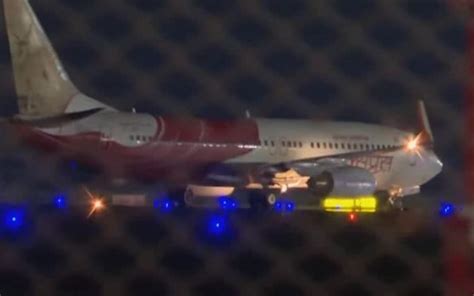
An Air India flight encountered significant malfunctions mid-air, leaving passengers in distress as in-flight entertainment, reading lights, and air conditioning systems failed, according to a video circulating online.
Passengers aboard an Air India flight found themselves in uncomfortable conditions after multiple onboard systems malfunctioned mid-flight. A video posted online reveals the extent of the issues, showing that reading lights, in-flight entertainment systems, and even the air conditioning ceased to function, leading to a stifling environment for those on board.
The incident, captured in a video that has since gone viral, showcases passengers fanning themselves with safety manuals and struggling to cope with the rising temperature inside the aircraft. The footage highlights not only the inconvenience but also raises concerns about the airline’s maintenance protocols and passenger safety standards.
“Video Shows Nothing Working on Air India Flight,” the original Yahoo News headline declared, underscoring the severity of the situation. The specific flight number and route were not immediately clear from the available reports, but the impact on passenger comfort was evident.
The video quickly spread across social media platforms, drawing criticism and sparking debate about the reliability of Air India’s aging fleet and the adequacy of their maintenance schedules. Several aviation experts weighed in, emphasizing the importance of functional environmental control systems (ECS) for passenger well-being, particularly on longer flights.
According to aviation safety regulations, an aircraft must maintain a safe and comfortable environment for its passengers. Malfunctioning air conditioning systems can lead to heat exhaustion, dehydration, and discomfort, particularly for vulnerable passengers such as the elderly, children, and those with pre-existing health conditions. The lack of reading lights and in-flight entertainment systems, while less critical, add to the overall negative passenger experience.
Air India has yet to release an official statement addressing the incident. However, sources familiar with the airline’s operations suggest that an internal investigation is underway to determine the root cause of the malfunctions and to implement corrective measures to prevent future occurrences.
The incident occurs as Air India undergoes a significant transformation following its acquisition by the Tata Group. The airline has embarked on an ambitious plan to modernize its fleet, enhance customer service, and improve its operational efficiency. However, this episode serves as a reminder of the challenges the airline faces in overcoming its legacy issues and meeting the expectations of its passengers.
Passengers who experienced the malfunctioning systems expressed their disappointment and frustration on social media, with many questioning whether they would choose to fly with Air India again in the future. Some passengers are reportedly considering filing complaints with aviation authorities, seeking compensation for the discomfort and inconvenience they endured during the flight.
Aviation analysts note that incidents like this can significantly damage an airline’s reputation, particularly in the age of social media, where news and opinions spread rapidly. Air India will need to act decisively to address the concerns raised by this incident and to demonstrate its commitment to passenger safety and comfort. This situation underscores the need for airlines to prioritize maintenance, conduct thorough pre-flight checks, and promptly address any malfunctions that occur during flights.
In addition to the immediate discomfort, the malfunctioning systems also raise questions about the potential impact on passenger health and well-being. Prolonged exposure to elevated temperatures and poor ventilation can exacerbate existing health conditions and increase the risk of heat-related illnesses. Aviation medical experts recommend that airlines have robust protocols in place to manage such situations, including providing passengers with adequate hydration and medical assistance if needed.
The Air India incident also highlights the importance of effective communication between the flight crew and passengers during emergencies or unusual situations. Passengers rely on the crew to provide accurate information, reassurance, and guidance, particularly when faced with unexpected challenges. A lack of clear communication can increase anxiety and undermine passenger confidence in the airline’s ability to handle the situation.
Industry observers suggest that the incident could prompt a broader review of Air India’s maintenance practices and safety protocols by aviation regulators. Regulators may conduct inspections of the airline’s facilities, review its maintenance records, and assess the competency of its maintenance personnel. Any deficiencies identified during these reviews could result in fines, sanctions, or other corrective actions.
The long-term implications of the incident for Air India’s reputation and financial performance remain to be seen. However, it is clear that the airline will need to take swift and decisive action to restore passenger confidence and to demonstrate its commitment to safety, reliability, and customer service. This may involve investing in new equipment, enhancing training programs, and implementing more rigorous maintenance procedures.
Air India’s challenges come at a critical time for the Indian aviation industry, which is experiencing rapid growth and increasing competition. Several new airlines have entered the market in recent years, offering passengers a wider range of choices and putting pressure on established carriers like Air India to improve their service and reduce their costs. The airline must demonstrate that it can compete effectively in this dynamic environment.
The incident also raises broader questions about the impact of aging aircraft on airline safety and reliability. Many airlines around the world operate older aircraft that require more frequent maintenance and are more prone to malfunctions. Aviation experts suggest that airlines should carefully consider the age and condition of their aircraft when making decisions about fleet renewal and maintenance investments.
The Air India incident serves as a stark reminder of the importance of prioritizing safety and reliability in the aviation industry. Passengers expect airlines to provide a safe and comfortable travel experience, and any failure to meet these expectations can have serious consequences for the airline’s reputation and financial performance. Airlines must continuously strive to improve their safety practices, maintenance procedures, and customer service to maintain the trust and confidence of their passengers.
Furthermore, the incident underscores the role of social media in shaping public perception of airlines and the aviation industry as a whole. In today’s interconnected world, news and opinions can spread rapidly across social media platforms, influencing consumer behavior and affecting the reputations of companies and organizations. Airlines must be proactive in monitoring social media and responding to passenger concerns in a timely and transparent manner.
The video evidence of the malfunctioning systems on the Air India flight has undoubtedly created a public relations challenge for the airline. To mitigate the damage and rebuild trust, Air India should consider the following steps:
- Issue a public apology to the passengers who were affected by the incident.
- Provide a detailed explanation of the root cause of the malfunctions and the steps being taken to prevent similar incidents in the future.
- Offer compensation or other forms of redress to the affected passengers.
- Conduct a comprehensive review of its maintenance practices and safety protocols.
- Communicate transparently with the public about the progress of its investigation and corrective actions.
By taking these steps, Air India can demonstrate its commitment to passenger safety and customer service and begin to restore its reputation. The airline’s response to this incident will be closely watched by passengers, regulators, and industry observers alike.
The incident underscores the complexities of managing an airline in the 21st century. Airlines face numerous challenges, including rising fuel costs, increasing competition, and evolving passenger expectations. To succeed in this environment, airlines must be agile, innovative, and customer-focused. They must also be committed to safety, reliability, and operational excellence.
Air India’s journey to recovery will be a long and challenging one. However, with the right leadership, strategy, and execution, the airline can overcome its legacy issues and emerge as a strong and competitive player in the global aviation market. The incident serves as a valuable learning experience for the airline and a reminder of the importance of continuous improvement and a relentless focus on passenger safety and satisfaction.
The broader context of this incident involves the global aviation industry’s ongoing efforts to enhance safety and reliability. Airlines, manufacturers, regulators, and other stakeholders are constantly working to improve aircraft design, maintenance procedures, pilot training, and air traffic management systems. These efforts have led to a significant reduction in the number of accidents and fatalities in recent decades.
However, incidents like the Air India malfunction highlight the fact that there is always room for improvement. Airlines must remain vigilant in their efforts to identify and mitigate potential safety risks and to ensure that their aircraft are properly maintained and operated. They must also be prepared to respond effectively to emergencies and unusual situations.
The Air India incident also underscores the importance of passenger rights and consumer protection in the aviation industry. Passengers have a right to expect a safe, comfortable, and reliable travel experience, and airlines have a responsibility to meet these expectations. When airlines fail to meet their obligations, passengers should have access to effective remedies, including compensation for damages and inconvenience.
Consumer advocacy groups play an important role in protecting passenger rights and holding airlines accountable for their actions. These groups work to educate passengers about their rights, advocate for stronger consumer protection laws, and represent passengers in disputes with airlines.
The Air India incident serves as a reminder that the aviation industry is a complex and interconnected system. Airlines, manufacturers, regulators, passengers, and other stakeholders all have a role to play in ensuring the safety, reliability, and sustainability of air travel. By working together, these stakeholders can create a more secure and enjoyable flying experience for everyone.
The event also brings up the issue of preventive maintenance schedules and adherence. The fact that multiple systems failed simultaneously suggests a potential lapse in the proper inspection and upkeep of the aircraft. Questions arise regarding the stringency of the maintenance checks carried out and whether these checks adequately cover all critical systems on board. An effective maintenance program should anticipate potential failures and address them proactively, rather than reactively after a malfunction occurs during a flight.
Moreover, the incident underscores the importance of cabin crew training and preparedness. While the reports focus on system malfunctions and passenger discomfort, the cabin crew’s response to the situation is also crucial. Were they adequately trained to handle such malfunctions? Did they provide clear and reassuring communication to the passengers? Did they take appropriate measures to mitigate the impact of the malfunctions on passenger health and safety? The cabin crew’s performance during the incident is an important factor in assessing the overall handling of the situation.
The incident also provides an opportunity for Air India to re-evaluate its customer service protocols. While safety is paramount, customer satisfaction is also essential for building loyalty and maintaining a positive reputation. Air India should consider how it can improve its communication with passengers before, during, and after flights, and how it can better address passenger concerns and complaints. This may involve investing in new technologies, such as mobile apps and online portals, and providing better training for its customer service representatives.
Finally, the Air India incident highlights the importance of transparency and accountability in the aviation industry. Airlines should be open and honest about any incidents that occur, and they should take responsibility for their actions. They should also be willing to cooperate with regulators and investigators to determine the root cause of incidents and to implement corrective measures. Transparency and accountability are essential for building trust with passengers and maintaining the integrity of the aviation system.
The incident is a stark reminder that even with advanced technology and stringent safety regulations, air travel is not without its risks. While the focus is on the malfunctions, the psychological impact on passengers should not be ignored. Experiencing such issues mid-flight can create anxiety and fear, particularly for those who are already nervous about flying. Airlines have a responsibility to address these concerns and to provide passengers with the support they need to feel safe and comfortable.
Frequently Asked Questions (FAQs)
-
What exactly happened on the Air India flight?
A video circulating online shows that multiple systems on an Air India flight malfunctioned mid-air. Specifically, the in-flight entertainment systems, reading lights, and air conditioning failed, creating uncomfortable conditions for the passengers. Passengers were seen fanning themselves with safety manuals to cope with the heat.
-
Has Air India responded to the incident?
As of the current reports, Air India has not yet released an official statement addressing the incident publicly. However, sources familiar with the airline’s operations suggest that an internal investigation is underway to determine the cause of the malfunctions and implement corrective measures.
-
What are the potential safety concerns related to malfunctioning air conditioning on a flight?
Malfunctioning air conditioning systems can lead to several potential safety and health concerns. These include heat exhaustion, dehydration, and general discomfort, especially for vulnerable passengers like the elderly, children, and individuals with pre-existing health conditions. In extreme cases, prolonged exposure to high temperatures and poor ventilation can exacerbate medical conditions and increase the risk of heat-related illnesses.
-
What actions might aviation authorities take in response to this incident?
Aviation regulators may conduct a thorough review of Air India’s maintenance practices and safety protocols. This could involve inspections of the airline’s facilities, a review of maintenance records, and an assessment of the competency of maintenance personnel. Any deficiencies identified during these reviews could lead to fines, sanctions, or other corrective actions mandated by the regulatory bodies.
-
What steps can Air India take to restore passenger confidence after this incident?
To restore passenger confidence, Air India could take several steps, including:
- Issuing a public apology to the affected passengers.
- Providing a transparent explanation of the root cause of the malfunctions and the corrective actions being implemented.
- Offering compensation or other forms of redress to the affected passengers.
- Conducting a comprehensive review of maintenance practices and safety protocols.
- Communicating openly with the public about the progress of the investigation and the implemented corrective measures.
- Investing in new equipment and enhancing training programs.
- Improving customer service protocols and communication with passengers.
By taking these steps, Air India can demonstrate its commitment to safety, reliability, and customer satisfaction.









